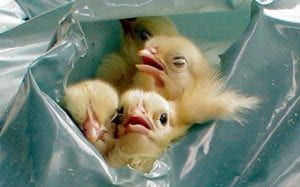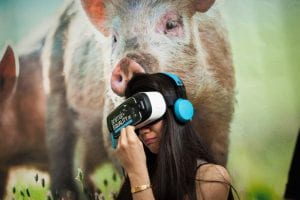My concept began quite broad as I contemplated both the focus of the game, which animal’s story would impact the player most, as well as the approach I would take in developing the game.
British farming has always been held in high regards with the use of consumer manipulation and false labelling – I was shocked to discover that many “free range” hens will never see the outdoors and spend their short lives cramped into a large shed. If an opening to the outdoors is available, it is often impossible to get to due to the large quantities of birds in one space – The Lion Quality Code of Practice stipulates one pop-hole per 600 birds to be open for 8 hours daily but farmers have been reported to even bend these regulations. Free range units visited by Viva! in 2015 have revealed birds inside dark, stinking, filthy sheds, the sheds; investigators documented hens who were extremely sick, and dead birds littered the filthy floor.
The egg industry certainly seemed to be a strong option for my game’s narrative. Most individuals understand the slaughter of animals for meat is undeniably cruel, but often avoid the topics of animal products such as milk and eggs in which the animal is forced to produce a product over and over until they are unable, and then slaughtered, making this torturous experience even more abhorrent. In the wild, hens would only lay 20 eggs in a whole year, but on modern-day farms hens are subjected to near constant lighting and fed high protein feed to increase egg production so they produce over 300 eggs a year.

Newborn chicks are more intelligent, alert, and aware of their environment than human toddlers, according to recent scientific studies, however the maceration, suffocation or gassing of day- old chicks is RSPCA approved standard practice in UK hatcheries – in my game the consequence of simply being born as a male will resort in “game over.” In each stage of the chicken’s life they face struggles offered to the player as a choice from the moment they hatch until they are “spent” (unable to lay eggs) and are taken to the slaughterhouse for their indefinite end.
I knew that for a game like this to be effective it must be true to the life of an average egg laying hen within UK animal farms. I reached out to several charities online who provide undercover footage inside farms and slaughterhouses that accurately represent the conditions the animals are kept in and events they are likely to experience – these types of video are captured by employees and welfare officers

as to retain an unbiased view. Animal Equality provided me with their iAnimal project in which they managed to capture 360 footage inside the farms and slaughterhouses of all popular UK “food” animal. They often offer these as VR experiences at vegan outreaches across the country and would be happy to work with me to provide footage for my game.
After much thought and the great responses I had, I decided to use film footage in my game similar to the format of the previously mentioned Bandersnatch multiple choice film, as I feel it will have more impact than an animated approach. The undeniable evidence of cruelty in the egg industry would be hard to ignore and hard hitting, in the same regards as popular animal advocacy documentaries such as The Land of Hope and Glory which shows every stage of the animal agriculture industry in Britain. The game will be as accessible as possible, potentially creating as a web game which could be easily shared and used at vegan outreach events. I will be looking at a few different game engines to see what will be right for my game whilst I write my branching narrative including Unity, RenPy and Game Maker.
The game will include all processes of the egg industry from birth until death
This is the standard life of a hen bred to produce eggs for major supermarkets and retailers across the world. Despite the misconception that UK hens have a much higher level of welfare and standard of life, all of these practices can be seen today.
Birth
Birds used as breeding stock will have their eggs taken away and incubated, usually in a hatchery; it will take approximately 21 days for the chicks to hatch. Newborn chicks are more intelligent, alert, and aware of their environment than human toddlers, according to recent scientific studies. In fact, many traits that were previously thought to be exclusive to human / primate communication, cognition and social behaviour have now been discovered in chickens.
Sexing
The newly hatched chicks are sent to the sexing part of the hatchery via conveyor system where the workers will determine their gender. Female chicks are valuable to the egg industry and will be crated up ready for their trip to rearing facilities and barns. Meanwhile male chicks will be disposed of, holding no value to the egg industry as they cannot lay themselves.Unlike broiler chicken bred for meat, these male chicks will never produce the same amount of meat and are disposed of soon after hatching. There are a few common ways these newly hatched chicks are killed; shred alive in a macerator, gassed, suffocated in plastic containers or ground alive in an auger. The bodies are sometimes used in the production of low grade animal feed and filler. Each one these methods are considered humane by animal welfare regulation.
Pullets
The female chicks are transported to rearing sites, egg farms or placed in rearing facilities at a hatchery before they reach maturity. These young laying hens or “pullets” will have access to large quantities of food to promote growth until they are able to lay eggs at 16 weeks of age. At this stage they are transferred to a laying facility where their eggs can be easily collected. A pecking order is often established at this point, which pullets often seen attacking one another.
Laying
The most efficient housing for egg laying hens are cages to which they will be confined until they’re spent and can no longer lay. Although battery cages are in the process of being eliminated by EU countries including the UK, they are often documented at egg laying facilities, replaced by enriched cages. These enriched cages provide a fraction more space than a battery cage with a nest box and some perching space; these usually house 10 birds.Caged hens will never see natural light and will never leave their cages and never breathe fresh air. The only time they will leave their cage is if they are sick, injured, die prematurely or when they are transported to slaughter. Other housing and laying facilities may consist of multi-tier aviaries, single-tier barn systems, free-range or free-run. However, these constitute a small minority of the housing systems used in overall global egg production. With the only source of light in egg laying facilities being artificial, it would be kept low to minimise hen activity.
Health
These popular caged hen systems come with a range of tragic health problems. Spending the majority of their lives on wire mesh floor will lead to damage on the hens feet, often getting themselves caught and tangled between the sharp wires. Hens have been observed standing on dead bodies of other hens to alleviate the discomfort of standing on a wire mesh floor 24/7. The physical and psychological stress caused by their environment and intensive housing often leads to feather loss and fatal illnesses. The air within these intensive farming sheds are toxic due to the high levels of ammonia from hen feces and urine. It is not uncommon for these gases to cause eye, viral and respiratory infections.
Slaughter
When a hen’s egg supply becomes depleted or in ill health where she can no longer produce, she is considered “spent” and sent to slaughter. This usually occurs somewhere around 78 weeks at a standard factory laying facility. These hens are roughly pulled from their cages, stuffed into crates, loaded onto trucks and taken to slaughter. After hours on the back of the slaughter truck, often without food or water they arrive at their final destination. The most common method of slaughter is live shackling – this is where a worker holds the bird upside down and jams the bird’s legs into a slotted shackle affixed to an overhead conveyor system. This conveyor system transports them to an electrified vat of water which is meant to render them unconscious, but is not 100% effective. Regardless of their level of consciousness they have their throats slit and then to a scalding tank for defeathering – even then they may still be alive due to slaughterhouse inefficiency.